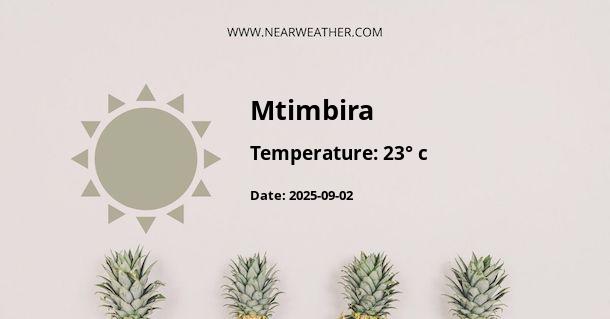Introduction
Mtimbira, located in Tanzania, is a region that promises a unique and fascinating weather pattern. Tanzania is known for its tropical climate, and Mtimbira is no exception. The region's climate is a tropical savanna climate with a short dry season. In this article, we will delve into the intricacies of the climate and weather patterns of Mtimbira, providing an in-depth analysis of the region's yearly weather conditions.
Climate Overview
Mtimbira experiences a tropical savanna climate, characterized by a distinct wet season and a short dry season. The region is relatively warm throughout the year, with average temperatures ranging from 20°C to 30°C. The warmest month is usually February, while July is the coldest. The region receives an average annual rainfall of approximately 800mm, with November through April being the wettest months.
Monthly Weather Breakdown
| Month | Average high (°C) | Average low (°C) | Rainfall (mm) |
|---|---|---|---|
| January | 30 | 20 | 75 |
The Wet Season
The wet season in Mtimbira, also known as the rainy season, begins in November and lasts through April. This period is characterized by heavy rainfall and slightly lower temperatures. The region receives the highest rainfall in March, with an average rainfall of about 150mm. The wet season is crucial for the region's agriculture, as the rainfall provides much-needed water for crop growth.
The Dry Season
The dry season in Mtimbira starts in May and ends in October. During this period, the region experiences minimal rainfall and high temperatures. The temperatures can reach up to 30°C during the day, with nights being relatively cooler. The dry season is an excellent time for tourists as the weather is conducive for outdoor activities and wildlife viewing.
Weather Variations and Anomalies
Like any other region, Mtimbira experiences occasional weather anomalies. These anomalies may be due to changes in global weather patterns, climate change, or other factors. For example, the region may experience unusually heavy rainfall during the dry season or prolonged drought during the wet season.
Such variations can have significant impacts on the region's agriculture and water supply, affecting both the economy and the livelihoods of the local population. Therefore, accurate and timely weather forecasts are essential for planning and decision-making in Mtimbira.
Conclusion
In conclusion, Mtimbira is a region with a tropical savanna climate characterized by a long wet season and a short dry season. The region's weather patterns and climate play a significant role in its agriculture, wildlife, and tourism. Understanding these patterns can help in planning various activities in the region, from farming to tourism. While weather anomalies do occur, they are relatively rare, and with accurate weather forecasting, their impacts can be managed effectively.
Whether you are a resident, a farmer, a tourist, or a researcher, understanding the climate and weather patterns of Mtimbira can provide valuable insights and enhance your experiences in this unique region of Tanzania.
A - Mtimbira's Latitude is -8.783330 & Longitude is 36.349998.
A - Weather in Mtimbira is 24° today.
A - Climate Conditions in Mtimbira shows overcast clouds today.
A - Humidity in Mtimbira is 87% today.
A - Wind speed in Mtimbira is 1.22 km/h, flowing at 104° wind direction. today.
